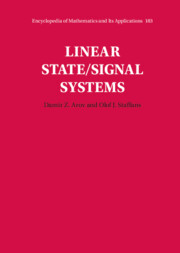Book contents
- Frontmatter
- Contents
- Preface
- Notations
- 1 Introduction and Overview
- 2 State/Signal Systems: Trajectories, Transformations, and Interconnections
- 3 State/Signal Systems: Dynamic and Frequency Domain Properties
- 4 Input/State/Output Representations
- 5 Input/State/Output Systems: Dynamic and Frequency Domain Properties
- 6 Bounded Input/State/Output Systems in Continuous and Discrete Time
- 7 Bounded Input/State/Output Systems in Continuous and Discrete Time
- 8 Semi-bounded Input/State/Output Systems
- 9 Semi-bounded State/Signal Systems
- 10 Resolvable Input/State/Output and State/Signal Nodes
- 11 Frequency Domain Input/State/Output Systems
- 12 Frequency Domain State/Signal Systems
- 13 Internally Well-Posed Systems
- 14 Well-Posed Input/State/Output Systems
- 15 Well-Posed State/Signal Systems
- Appendix A Operators and Analytic Vector Bundles in H-Spaces
- References
- Index
2 - State/Signal Systems: Trajectories, Transformations, and Interconnections
Published online by Cambridge University Press: 05 May 2022
- Frontmatter
- Contents
- Preface
- Notations
- 1 Introduction and Overview
- 2 State/Signal Systems: Trajectories, Transformations, and Interconnections
- 3 State/Signal Systems: Dynamic and Frequency Domain Properties
- 4 Input/State/Output Representations
- 5 Input/State/Output Systems: Dynamic and Frequency Domain Properties
- 6 Bounded Input/State/Output Systems in Continuous and Discrete Time
- 7 Bounded Input/State/Output Systems in Continuous and Discrete Time
- 8 Semi-bounded Input/State/Output Systems
- 9 Semi-bounded State/Signal Systems
- 10 Resolvable Input/State/Output and State/Signal Nodes
- 11 Frequency Domain Input/State/Output Systems
- 12 Frequency Domain State/Signal Systems
- 13 Internally Well-Posed Systems
- 14 Well-Posed Input/State/Output Systems
- 15 Well-Posed State/Signal Systems
- Appendix A Operators and Analytic Vector Bundles in H-Spaces
- References
- Index
Summary
Chapter two considers the interwoven interests of individual participants, collectives interests and the wider public interests in research using linked data. The chapter discusses the research participants interests including dignity, autonomy and privacy and the traditional approaches to protecting them — consent and anonymisation — and concludes that these do not operate to effectively to protect individual interests in this context. Research using linked data can also have impacts, both beneficial and harmful on others, including socio-demographic groups, disease groups and the wider community and these should be explicitly recognised and evaluated by decision makers. The current legal and ethical regulation of data linkage research are critiqued for being too individualistic and alternative approaches are discussed.
Keywords
- Type
- Chapter
- Information
- Linear State/Signal Systems , pp. 71 - 131Publisher: Cambridge University PressPrint publication year: 2022

